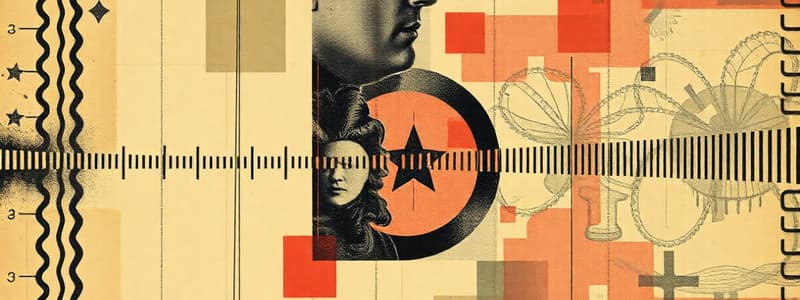Podcast
Questions and Answers
What is the next number in the sequence: 3, 83, 152, 209, 253, ?
What is the next number in the sequence: 3, 83, 152, 209, 253, ?
- 294
- 283 (correct)
- 295
- 284
The difference between the first two numbers in the sequence (3 and 83) contributes to the pattern of decreasing differences.
The difference between the first two numbers in the sequence (3 and 83) contributes to the pattern of decreasing differences.
True (A)
What is the pattern of differences between consecutive numbers in the sequence 3, 83, 152, 209, 253?
What is the pattern of differences between consecutive numbers in the sequence 3, 83, 152, 209, 253?
The differences decrease by 11 each time.
The pattern in the given sequence is based on the ______ differences between consecutive numbers.
The pattern in the given sequence is based on the ______ differences between consecutive numbers.
Match the following terms with their corresponding descriptions in the context of the provided sequence:
Match the following terms with their corresponding descriptions in the context of the provided sequence:
What is the required term for the sequence 26, 15, 18, 41, 150?
What is the required term for the sequence 26, 15, 18, 41, 150?
The 5th term in the sequence 1, 2, 5, 16 is found using the formula of multiplying the 4th term by 4 and adding 12.
The 5th term in the sequence 1, 2, 5, 16 is found using the formula of multiplying the 4th term by 4 and adding 12.
What term follows 160 in the sequence 6, 14, 32, 72, 160?
What term follows 160 in the sequence 6, 14, 32, 72, 160?
In the sequence 3, 1, 2, 5, 16, the 6th term can be calculated as the 5th term multiplied by ____ and added to 24.
In the sequence 3, 1, 2, 5, 16, the 6th term can be calculated as the 5th term multiplied by ____ and added to 24.
Match the sequence number with its corresponding formula:
Match the sequence number with its corresponding formula:
Find the 4th term in the sequence 1414, 1322, 1365, 1371.
Find the 4th term in the sequence 1414, 1322, 1365, 1371.
To find the first term in the sequence 1, 2, 5, 16, we divide the second term by 2.
To find the first term in the sequence 1, 2, 5, 16, we divide the second term by 2.
What is the pattern that generates the sequence 1414, 1322, 1365, 1371?
What is the pattern that generates the sequence 1414, 1322, 1365, 1371?
What is the result of the expression 22646 - 19136?
What is the result of the expression 22646 - 19136?
The 4th term in the sequence is 41.
The 4th term in the sequence is 41.
What is the value of ? in the expression ?% of 3510 = 117?
What is the value of ? in the expression ?% of 3510 = 117?
For the equation 54.(?)^3 + 543 + 5.43 = 603.26, the value of ? is _____ .
For the equation 54.(?)^3 + 543 + 5.43 = 603.26, the value of ? is _____ .
What is the final value of ? in the equation 80% of 560 + (?)% of 200 = 70% of 900?
What is the final value of ? in the equation 80% of 560 + (?)% of 200 = 70% of 900?
The expression √(3440 - 524) - √(1686 - 317) equals 19.
The expression √(3440 - 524) - √(1686 - 317) equals 19.
Calculate the value of ? in the expression 100 * 0.5 * √? = 900 ÷ 2.
Calculate the value of ? in the expression 100 * 0.5 * √? = 900 ÷ 2.
Match the following terms with the correct values:
Match the following terms with the correct values:
Flashcards
Arithmetic Sequence
Arithmetic Sequence
A sequence where each term is generated through a formula based on previous terms.
Percentage Calculation
Percentage Calculation
Finding what percent a number is of another number.
Square Root
Square Root
A number that, when multiplied by itself, gives the original number.
Algebraic Equation
Algebraic Equation
Signup and view all the flashcards
Subtraction
Subtraction
Signup and view all the flashcards
Multiplication
Multiplication
Signup and view all the flashcards
Equation Balance
Equation Balance
Signup and view all the flashcards
Order of Operations
Order of Operations
Signup and view all the flashcards
First term in sequence
First term in sequence
Signup and view all the flashcards
Second term calculation
Second term calculation
Signup and view all the flashcards
Third term calculation
Third term calculation
Signup and view all the flashcards
Fourth term calculation
Fourth term calculation
Signup and view all the flashcards
Fifth term calculation
Fifth term calculation
Signup and view all the flashcards
Required term equation
Required term equation
Signup and view all the flashcards
Sequence pattern: 6, 14, 32
Sequence pattern: 6, 14, 32
Signup and view all the flashcards
Predicting future terms
Predicting future terms
Signup and view all the flashcards
Number Series Pattern
Number Series Pattern
Signup and view all the flashcards
Difference Between Terms
Difference Between Terms
Signup and view all the flashcards
Decreasing Differences
Decreasing Differences
Signup and view all the flashcards
Predicting Next Number
Predicting Next Number
Signup and view all the flashcards
Final Answer Selection
Final Answer Selection
Signup and view all the flashcards
Study Notes
Quantitative Aptitude - Set 1
- Question 1: The sequence follows a pattern in the differences between consecutive numbers. The differences decrease in a predictable way (-11,-12,-13,-14). The next difference would be -15, resulting in 283.
- Question 2: Find the next number in a sequence based on a pattern where each term is a function of the previous term. The pattern is: term n = term (n-1) * n + (n+1), creating the answer 1371.
- Question 3: The sequence has a pattern where each number is a function of the preceding term. The pattern is: term n= term(n-1)*(n-1)+(n). This pattern generates the fifth term as 76 .
- Question 4: The sequence shows a pattern where each term is created by doubling the preceding one plus a progressive increment. (x2+ increment). Following the pattern, the next term is 352
- Question 5: The pattern in the sequence involves multiple operations applied to a previous term. The pattern is term n = term (n-1) *n- increment, generating a next term of 735
- Question 6: Find the missing percentage to satisfy the equation, resulting in the answer 10/3.
- Question 7: An equation involving square roots guides calculating the answer which equals 17.
- Question 8: The equation involves percentage calculations and percentages, resulting in 81.
- Question 9: Find x to solve the equation given, resulting in the answer 54.83
- Question 10: Calculate based on the given compound equation involving percentage calculations, resulting in 91.
Studying That Suits You
Use AI to generate personalized quizzes and flashcards to suit your learning preferences.




